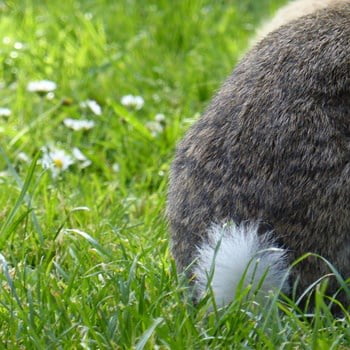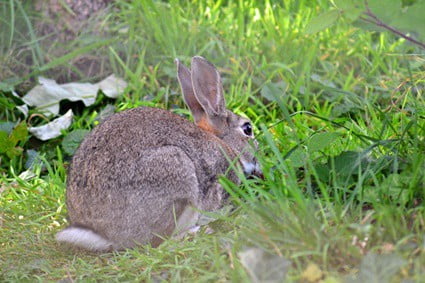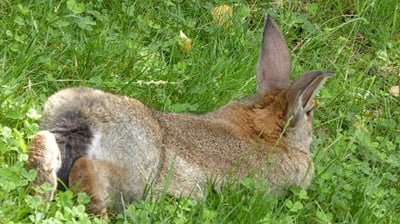A rabbit’s tail is one of its most iconic features. The cute, ‘cotton’ fluff of the tail is immediately recognizable and eye-catching. However, being so small and precious, it’s difficult to see the functional purpose of a tail. This can lead owners to wonder if bunny tails are just for show.
A rabbit’s tail serves two main purposes. Its most important role is in helping rabbits escape predators in the wild. The ‘scut’ (or tail) of a bunny has a pale underside which shows when the rabbit runs. This distracts any predator chasing it and buys it precious time to escape. Aside from that, a rabbit’s tail can help it signal other rabbits when danger is present.
In a domestic setting, you’ll find a rabbit using its tail to show emotion. For example, your bunny might wag its tail if it’s annoyed with you. If it’s chasing its tail, this could indicate the rabbit is bored, frustrated, or interested in mating. As expressive as bunny tails are, most rabbits do not like their tails touched or handled. That’s to be expected, as the structure of it is rather delicate.
Do Rabbits Need Tails?
A tail is a seemingly innocuous and useless part of a rabbit’s body. However, bunny tails are actually crucial to its chances of survival in the wild.
Experts like Graham Hickman have found that the mammalian tail (found in all mammals, including rabbits) is often a multipurpose appendage. So, it may be one of the smallest and most fragile parts of your rabbit’s body. However, it’s also the most versatile appendage it has. Your rabbit’s tail can be used to:
- Communicate
- Signal
- Escape danger
Of course, two of these functions are not necessary for domestic rabbits. Knowledge of how to use the tail for survival purposes will remain ingrained in all pet rabbits as instinct. However, a domestic bunny should never have practice in using the tail to escape quickly-pursuing predators.
Instead, you’ll notice your rabbit’s tail being used to show feelings and communicate with other rabbits. Brain Research found that blood flow into a rabbit’s tail and ears can be used to determine its health and wellbeing. It also shows a reaction to physiological stimuli.
As such, your pet rabbit may not require its tail to safely navigate its environment. However, it can still use it to display its emotions and communicate with you. You can also use the tail as a benchmark to double check that your rabbit is healthy and happy.

What is a Rabbits Tail Made Of?
Your rabbit’s tail may look like nothing more than a small lump of flesh covered in fur. However, it actually contains a small bone. This bone is connected to the rabbit’s spine and is incredibly fragile.
The tail does have a small amount of muscle around it to help it move. Even still, it’s not very strong. That’s why you must be careful playing with your rabbit. Even a small tug or jerk could break or dislocate this small bone. That would cause real pain and damage.
What is the Name of a Rabbit’s Tail?
A rabbit tail even has a special name thanks to its short and stiff nature. It’s called a ‘scut,’ a term shared with deer that also have scut tails (though theirs come to a point).
This is a very old name, first seen in around 1440. It was a reference to the very short, erect tail seen on rabbits, but also on deer and other woodland animals. Other animals which have a ‘scut’ tail include:
- Hares
- Goats
- Moose
- Bears
The precise origin of this word is not truly known. However, many believe it to be related to the now obsolete adjective ‘scut,’ meaning short. Bigger animals with scut tails, like moose and bears, have very little use for them. In contrast rabbits, hares, and deer can use them to communicate with each other (and other animals).
How Rabbits Use Their Tails
We know rabbits use their tails to communicate and escape danger. But how does a fluffy bundle of fur accomplish that? This is mainly due to the coloring and shape of the tail.
The bright, white fur on the underside of a rabbit’s tail may seem out of place. After all, most rabbits have browns and greys for the rest of their coat. This is designed to help them blend with the undergrowth. In contrast, the white can be very eye-catching – and that’s a good thing.
Previously, evolutionary biologists thought this conspicuous tuft had something to do with mating rituals or even territorial signaling. Now, scientists at the University of Göttingen have found otherwise. This characteristic serves two distinct purposes:
- A flick of the rear to show this white fur can communicate a very clear message. All nearby animals will understand that danger is close.
- The repetitive flashing of this white tuft when running can disorientate predators. This gives the rabbit a tactical advantage of sorts.
Why Do Rabbits Flash Their Tail When They Run?
The flashing of a rabbit’s tail is a somewhat involuntary action. However, they can emphasize it to create a more dramatic effect. A study undertaken by Dirk Semmann points out the clear advantage of this. It confuses predators.
When a rabbit is running, the flashing white tail creates a focal point. Animals giving chase become fixated on it. As the rabbit makes a sharp turn, the focal point shifts and can even disappear. This compels the predator to constantly refocus on this focal point. That can prevent it from pushing to reach its top speed as it tries to strategize.
Furthermore, the white distraction can act as a decoy or red herring. It will confuse the predator as to which way the rabbit intends to move. Semmann was able to test this with a simple video game. It required participants to guess which way a rabbit was about to turn as it ran.
There were two versions; one in which the rabbit had a classic ‘cotton tail’ and one in which it did not. In the version where the rabbit had a white tail, the participants made more mistakes more often. The time it took them to make a guess remained the same. This seemingly small edge is crucial for rabbits in the wild.
Why Does A Rabbit Flash Its Tail While Sitting?
Aside from confusing predators, you may notice a pet rabbit flashing its tail while holding still. That’s because it’s signaling.
In this case, a rabbit raises its tail and starts to flash, and perhaps thump. With this display, it is warning nearby rabbits that danger is approaching. That can buy precious time for its family group.
In many cases, a rabbit does this when it is unlikely to escape danger itself. Rather than engaging in a futile escape attempt, it sends out a signal to other animals. This seemingly altruistic and selfless act also serves an evolutionary purpose. It contributes to the survival of family groups and warrens.
Do All Rabbits Have White Tails?
Because the white flashing serves a great purpose, you may wonder if that’s a mandatory feature in all rabbits. Actually, it’s not.
Almost all wild rabbits have white tails of some form. However, this is not the case for domestic rabbits. The selective breeding process has created many domesticated breeds that display unique colors or traits. Their color variations also have an effect on their tails.
Domesticated rabbits may have smaller or even longer tails. They are more likely to be the same color as the rest of their coat.
Even still, certain species of wild rabbit may have slightly different tails and colorations. Cottontail rabbits, for example, are most commonly associated with the classic white tail. Meanwhile, black-tailed jack rabbits have, unsurprisingly, black tails. Snowshoe hares are white all over. These differences have evolved to give different breeds an advantage in their natural habitats.
Do Rabbit Tails Help with Balance?
For most animals, tails help in one primary way: they provide and enhance balance. This is also true for rabbits. However, wild rabbits have rather short tails, so the advantage is limited.
In a small degree, you will still see a rabbit use its tail as a counterbalance when making sharp turns. If they’re going left, the tail will shift right. However, a rabbit won’t rely on this very much. Instead, if it needs to corner sharply, it will binky – or jump and twist in the air.
Can A Rabbit Lose Its Tail?
A rabbit can lose its tail quite easily, in fact. This is both a side effect of the fragility of the tail bone and a useful survival mechanism. If a predator were to grab a rabbit by its tail, for example, the tail is likely to break away, giving the rabbit a chance to escape.
Of course, this fragility also means that people can harm their rabbits without meaning to. That’s especially true for young children.
It is important to note, however, that a rabbit will not simply ‘lose’ its tail. This only happens when something is very wrong.
What If My Rabbit’s Tail Falls Off?
Then it has most likely sustained serious damage that severed the tail. It only remained attached by a small amount of skin or hair. Alternatively, your rabbit may have a serious medical condition that limits blood flow. Possible causes also include:
- The tail was pulled or jerked
- The tail was severed
- Another animal bit the tail off
- The rabbit bit its own tail off
- A small injury resulted in a severe infection or necropsy
There is no reason why you’d fail to notice an infection severe enough to cause gangrene or necropsy in the tail. As such, it’s highly unlikely to be the reason for your bunny’s lost tail. An exception would be if you recently came into possession of a rabbit which has been malnourished or neglected.
Why Would a Rabbit Bite Its Tail Off?
It may seem implausible that a rabbit would bite its own tail off. However, there are actually a number of reasons why a rabbit may do this. For example:
- It has mites
- It has an injury to its spine or hind causing numbness
- It has suffered from extreme and prolonged stress or trauma
- It has a genetic predisposition to self-mutilation
If your rabbit makes repeated attempts to bite its own tail, you should take it to the vet immediately.
Does A Rabbit’s Tail Grow Back?
Tail loss is permanent for rabbits. This is because the tail has a small bone inside. The shape of the tail is built around this bone and the muscles then support and move it. Once the tail has been amputated, the wound will simply heal over.
The fur around the area may grow back. However, if a rabbit is born with no tail or its tail is severed for some reason, it will not grow back as a functional limb.
This is not a huge problem for domestic rabbits, so long as they are properly treated. They do not rely on the tail for anything other than communicating. This can, however, be fatal for wild rabbits. In the short-term, they may experience infection or blood loss. In the long-term, tail loss can leave rabbits unable to safely evade predators.
Why Does My Rabbit Wag Its Tail?
Tail-wagging is a common habit among animals with tails. However, the meanings can vary wildly depending on the species. For example, a dog wagging its tail may be a sign of happiness, excitement, or contentment overall. However, for a rabbit, wagging its tail is a sign of defiance and irritation.
Say you put your rabbit back in its hutch after time in the backyard. If it wags its tail, then your rabbit is telling you that it is annoyed by this. It probably wants to go back outside.
Alternatively, a rabbit may gently wag its tail during an interaction with another rabbit. This is a way to lightly mock or annoy that rabbit. Think about it as the rabbit equivalent of one child sticking out a tongue at the other. It’s unlikely to cause a fight, but it’s designed to leave a rude impression.

Why Is My Rabbit Chasing Its Tail?
While the habit is more commonly associated with dogs, a rabbit will, in fact, chase its tail. There are a number of reasons for this habit, such as:
Boredom
Domestic rabbits are intelligent, high-energy creatures that require a lot of interaction and stimulation. If your rabbit is pacing or repeatedly chasing its tail, it likely needs mental stimulation or more physical exercise in order to be content. In lieu of these fun distractions, it’s trying to create its own entertainment.
You could try buying some puzzle toys, or letting it out to stretch its legs more often.
Arousal
Though not every pet owner’s first thought, tail-raising can indicate sexual arousal. When rabbits are signaling interest in mating, they often circle and wag their tails. This will be accompanied by many other physical and vocal cues.
As such, your rabbit may seem to be in good health, but repeatedly circle, chase its tail, or hum. This is a sign that it is sexually frustrated.
Itchiness Or Discomfort
Less positive reasons for this behavior could include:
- Itchiness
- Fleas
- The presence of a tick
- A more serious medical condition, causing your rabbit to try to bite or sever its own tail
If it is trying to bite or chew its rear end or hind legs, then the problem is more likely with its skin. However, if your rabbit is trying to bite its tail specifically, then the problem is likely in its spine or hind legs.
Illness
Watch out if your rabbit seems to just be running or staggering in circles. It may have an underlying neurological issue. If you have any suspicion that your rabbit is chasing its tail for negative reasons, you should take it to the vet immediately for a check-up.
Are Rabbits Defensive Of Their Tails?
A rabbit will generally not be pleased if you try to touch its tail. In response, it may:
- Wriggle away
- Thump
- Growl
- Wag its tail
- Try to bite you
This is because rabbit tails are incredibly sensitive.
Why Does My Rabbit Scream When I Touch Its Tail?
If your rabbit screams when you touch its tail or hind quarters, there is something very wrong.
Rabbits are often considered the archetypal prey animal. They are almost always silent, which is to their advantage. They very rarely whimper, yelp, or scream when in pain. This is partly to do with their pain tolerance, but also the ways in which they mask pain. According to the British Veterinary Association, rabbits are so good at masking pain that assessing pain in bunnies requires a specialist approach.
So what if your rabbit screams when you touch certain parts of its body? Then you can be absolutely certain it is either incredibly frightened or in a great deal of pain. Because of this, you should take your rabbit to the vet and discover the root problem.
Why Do Rabbits Stretch Out Their Tail?
You may find your rabbit jutting its tail out farther than normal. It might not flash it, but simply stretch it. This is a form of body language. From it, you can learn something about the state of your rabbit’s mind. Bunnies stretch their tails when they’re:
- Investigating
- Relaxing
If your bunny is lounging on its belly, it will often stretch out its legs, spine, and the tail with it. If your bunny is sniffing around an object or room, however, the meaning is quite different. Your pet is prepared to flee if whatever it discovers isn’t good. This will be made easier if the bunny is primed and ready. You may not be able to see its tense muscles under its fur – but the tail is in clear view and easy to spot.
All in all, rabbits’ tails are important for expression and practical survival situations. Despite being small, short, and fragile, a bunny’s tail is indispensable. If your rabbit were to lose it by accident, it can still survive and live happily. In the wild, however, that would place it at a disadvantage.

